外研版(2019)选择性必修第二册Unit 2 Improving yourself Developing ideas 课件(共49张PPT)
文档属性
| 名称 | 外研版(2019)选择性必修第二册Unit 2 Improving yourself Developing ideas 课件(共49张PPT) | 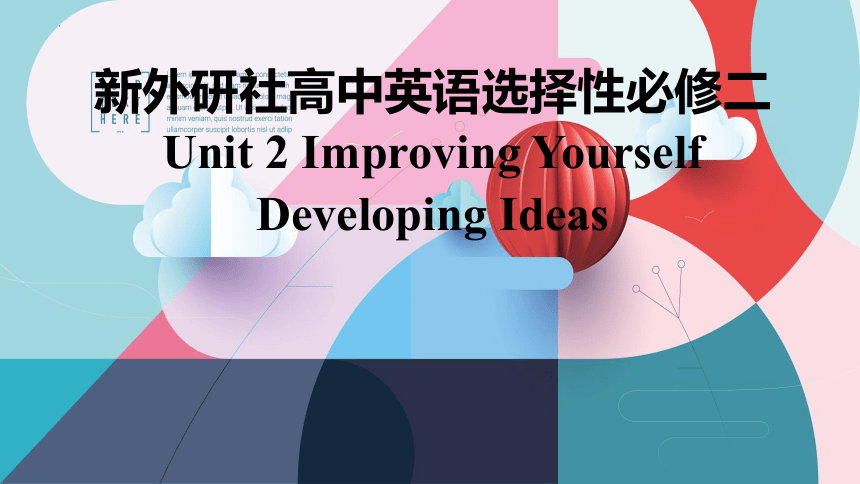 | |
| 格式 | pptx | ||
| 文件大小 | 6.8MB | ||
| 资源类型 | 教案 | ||
| 版本资源 | 外研版(2019) | ||
| 科目 | 英语 | ||
| 更新时间 | 2023-05-18 12:35:07 | ||
图片预览


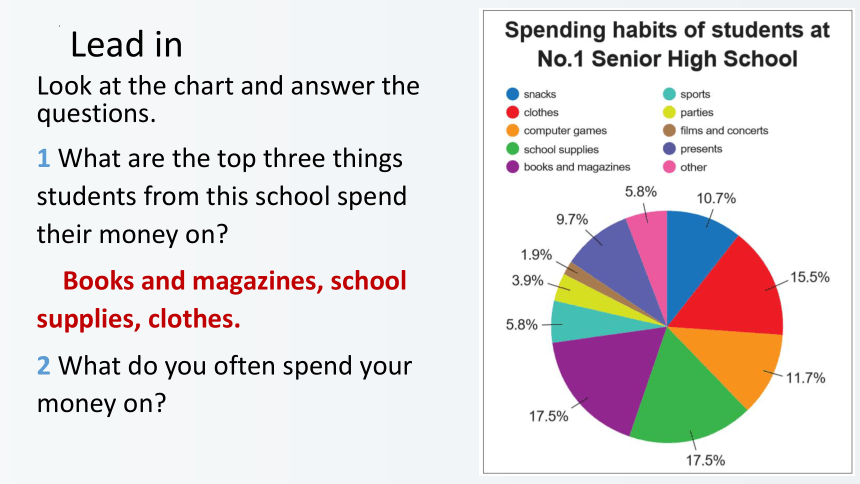

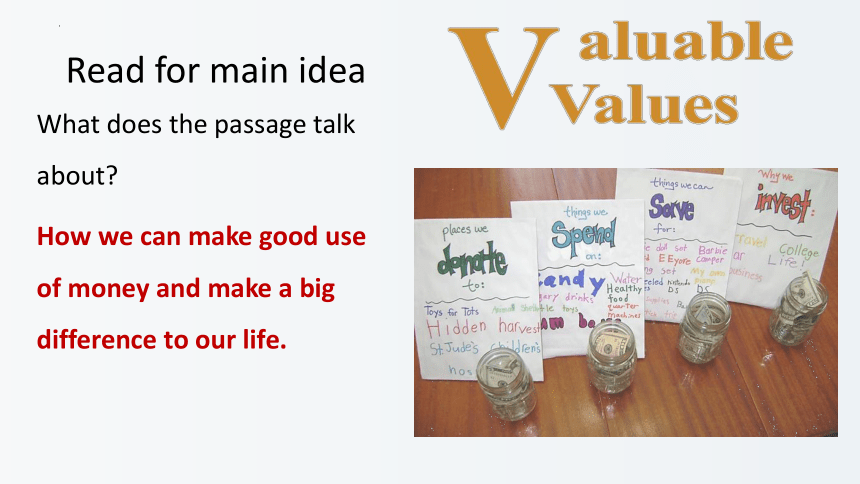
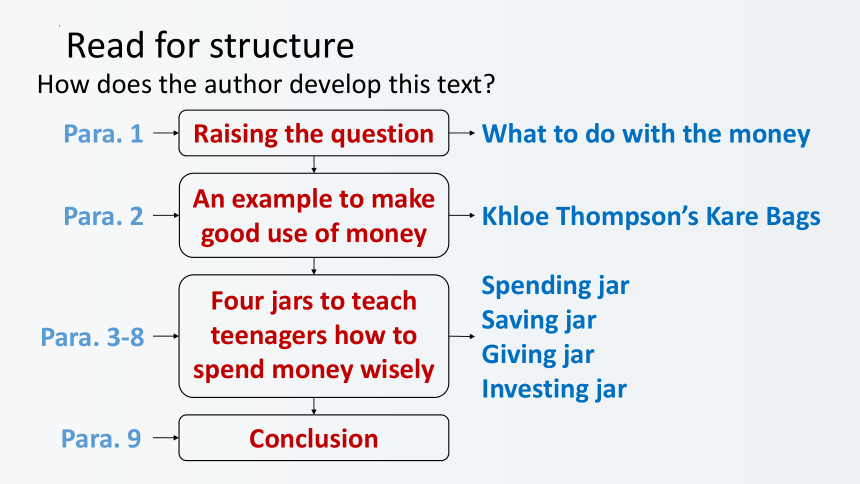
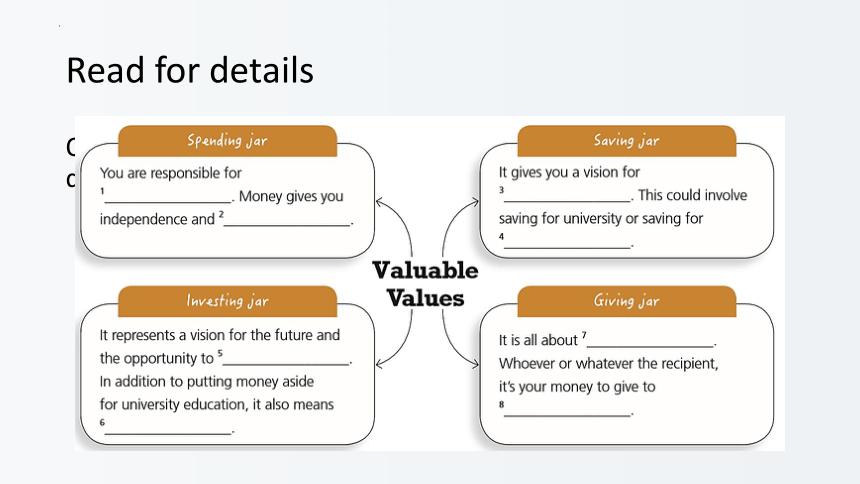
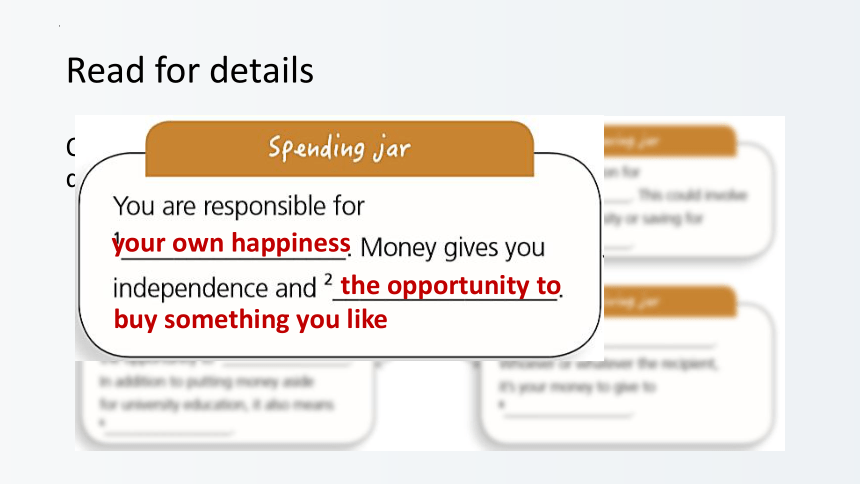
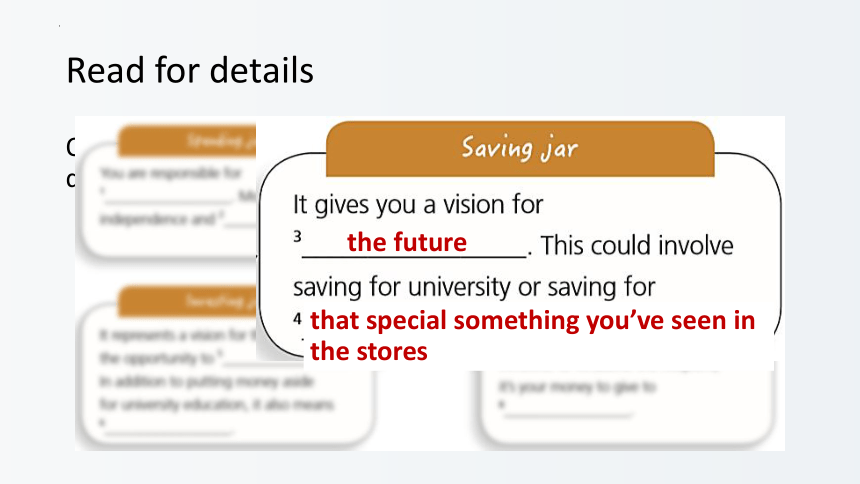
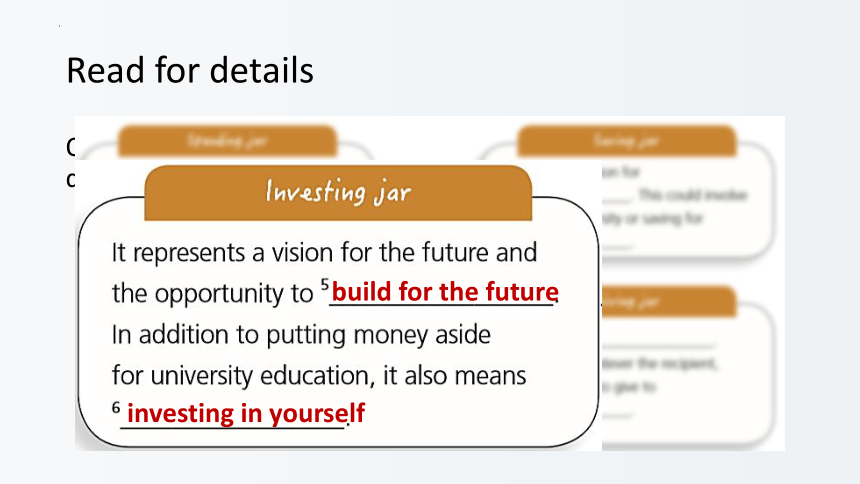
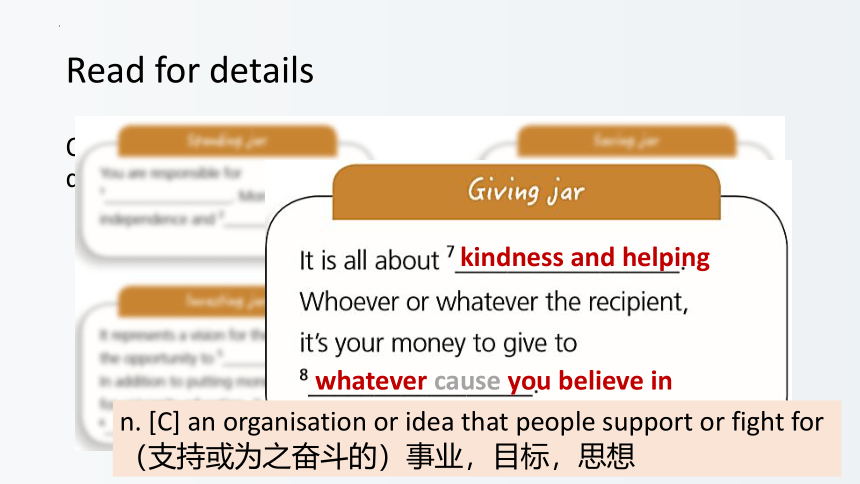
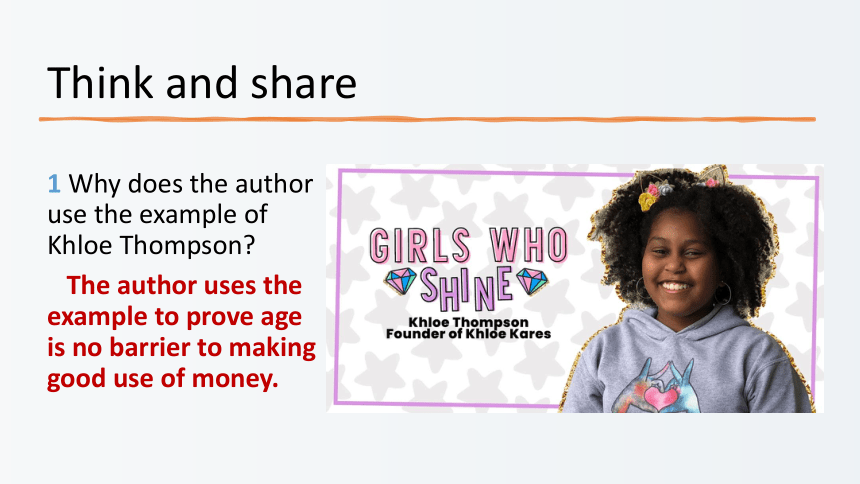
文档简介
(共49张PPT)
新外研社高中英语选择性必修二Unit 2 Improving Yourself
Developing Ideas
Reading
Lead in
Look at the chart and answer the questions.
1 What are the top three things students from this school spend their money on
Books and magazines, school supplies, clothes.
2 What do you often spend your money on
Lead in
Predict what the passage talks about based on the tile and pictures.
Read for main idea
What does the passage talk about
How we can make good use of money and make a big difference to our life.
How does the author develop this text
Read for structure
Raising the question
What to do with the money
An example to make good use of money
Khloe Thompson’s Kare Bags
Four jars to teach teenagers how to spend money wisely
Spending jar
Saving jar
Giving jar
Investing jar
Conclusion
Para. 1
Para. 2
Para. 3-8
Para. 9
Read for details
Organise information from the passage and complete the diagram.
Read for details
Organise information from the passage and complete the diagram.
the opportunity to buy something you like
your own happiness
Read for details
Organise information from the passage and complete the diagram.
the future
that special something you’ve seen in the stores
Read for details
Organise information from the passage and complete the diagram.
build for the future
investing in yourself
Read for details
Organise information from the passage and complete the diagram.
kindness and helping
whatever cause you believe in
n. [C] an organisation or idea that people support or fight for
(支持或为之奋斗的)事业,目标,思想
Think and share
1 Why does the author use the example of Khloe Thompson
The author uses the example to prove age is no barrier to making good use of money.
2 How does the passage inspire you to improve your spending habits
Raising the question
What to do with the money.
An example to make good use of money
Khloe Thompson’s Kare Bags
Four jars to teach teenagers how to spend money wisely
Spending jar/Saving jar/ Giving jar/Investing jar
Conclusion
Para. 1
Para. 2
Para. 3-8
Para. 9
Think more objectively about money.
Understand the value of the valuable.
Make informed choices.
…
Think and share
3 What’s your understanding of this title
very useful or important
很有用的;很重要的
worth a lot of money 很值钱的
[pl.] beliefs about what is right and wrong and what is important in life 是非标准;生活准则;价值观
moral values 道德信条
[U] how much sth. is worth in money or other goods for which it can be exchanged (商品)价值
Useful rules or beliefs on how you spend your precious things
The spending power of young people 1 ________(vary) from person to person. Each, however, 2 ________(face) with the same question: what to do with their money Some teens may spend their money on online activities 3________ others can make good use of money. For instance, with her grandmother`s help, eight-year-old Thompson started making “ Kare Bags” containing 4 ________(necessity) for the homeless, which made their lives 5 ________(easy) . It’s important for younger generations to know an appropriate way to spend money. Thanks to Jerry, he put forward a method to teach teenagers 6 ________ to spend money wisely. When Jerry’s grandchildren turned 13, his present to each of them was three jars for Spending, Saving, and Giving——he has since added a fourth jar for investing. It was from then on 7 ________his grandchildren started to be in control of the money they received. The present is more than a few jars——he is giving them the opportunity 8 ________(learn) lifelong values. The wider aim of the jars is to encourage teenagers to think 9 ________( objective) about money and what it can do. In a word, this method will make a 10 ________(different) to teenagers’future.
Post reading -Fill in the blanks.
The spending power of young people 1 varies__(vary) from person to person. Each, however, 2 is faced__(face) with the same question: what to do with their money Some teens may spend their money on online activities 3 while_ others can make good use of money. For instance, with her grandmother`s help, eight-year-old Thompson started making “ Kare Bags” containing 4 necessities_(necessity) for the homeless, which made their lives 5 easier___(easy) . It’s important for younger generations to know an appropriate way to spend money. Thanks to Jerry, he put forward a method to teach teenagers 6 how__ to spend money wisely. When Jerry’s grandchildren turned 13, his present to each of them was three jars for Spending, Saving, and Giving——he has since added a fourth jar for investing. It was from then on 7 that_ his grandchildren started to be in control of the money they received. The present is more than a few jars——he is giving them the opportunity 8 to learn_(learn) lifelong values. The wider aim of the jars is to encourage teenagers to think 9 objectively___( objective) about money and what it can do. In a word, this method will make a 10 difference___(different) to teenagers’future.
Writing
Read the story and answer the questions.
Pre-writing
There once was a little boy who had a bad temper. His
father gave him a bag of nails and told him that every time
he lost his temper, he must hammer a nail into the back of
the fence.
Pre-writing
The first day, the boy hammered so many nails into the fence that his father had to give him a whole new bag. Over the next few weeks, as he learnt to control his anger, he hammered fewer and fewer nails into the fence each day. He had learnt that it was easier to hold his temper than to hammer nails into the fence. Finally, the day came when the boy didn’t lose his temper all day, not even once. He told his father, who said that now the boy should pull out one nail for each day that he was able to hold his temper.
Read the story and answer the questions.
Pre-writing
The days passed by and the boy was finally able to tell his father that all the nails were gone. The father took his son and led him to the fence. He said, “You’ve done well, son, but look at all the holes in the fence! That fence will never be the same. When you say something in anger, it leaves a hole in someone’s heart, just like your nails have left holes in the fence. It doesn’t matter how many times you say sorry. The hole is still there.”
Read the story and answer the questions.
Pre-writing
1. What aspect of self-management is the passage about
The passage is about how to control one’s own temper.
Read the story and answer the questions.
Pre-writing
The story tells us the importance to learn how to control our temper, or else we will hurt someone’s feelings when saying something in anger.
2. What message do you think the story conveys
Read the story and answer the questions.
The structure of the passage.
Pre-writing
A story
The process of the story
The beginning of the story
The end of the story
Make a brief summary of the story.
Pre-writing
How to write a summary
write the main points of a story you read. It should be brief, and not conclude your own opinion about it, which means you should think about what is the most important things to say in the story and use your own words to describe it.
Make a brief summary of the passage.
Pre-writing
The beginning
Character
What happened
Topic sentence
Once there was a boy with a bad temper. His dad told him to hammer a nail into the fence every time he lost his temper.
Make a brief summary of the passage.
Pre-writing
The process of the story
The boy learnt to control his temper because it was easier than hammering the nails into the fence. Then his dad asked him to pull one nail out every time he was able to hold his temper.
supporting sentences
write the process in time order briefly
Make a brief summary of the passage.
Pre-writing
The end of the story
concluding sentences
When the boy pulled out all the nails, his dad showed him the holes in the fence, telling him his anger had left “scars” that would never heal, like the holes in the fence.
Write a reflection after reading the story.
While-writing: Writing
What is a reflection
A reflection is about your feelings and thinking after you read a book or a story, and when you write it, you should first introduce the book or the story you read, and you can also introduce some unforgettable plots in it, then clarify your thoughts and what it brings you after reading.
While-writing: Writing
A reflection consists of three elements:
a summary of the story
your thoughts after reading the story
conclude your ideas
Write a reflection after reading the story.
Make notes about the story in Activity 5.
While-writing: Writing
Summary of the story:
_________________________________________My thoughts:
_________________________________________
Conclusion:
_________________________________________
Now write a reflection.
While-writing: Writing
Summary of the story:
__________________________
My thoughts:
__________________________
Conclusion:
__________________________
My reflection:
______________________________________________________________________
Post-writing: Presentation
Post-writing: Evaluation
Questions Your evaluation Evaluator
Does the reflection include the key points 4 2 0
Is the reflection organized properly and smoothly 3 2 1 How is the language 12 8 4 How is the handwriting 3 1 -1 Paper design 3 1 -1 TOTAL MARK
Post-writing: Reference Text
Once there was a boy with a bad temper. His dad told him to hammer a nail into the fence every time he lost his temper. The boy learnt to control his temper because it was easier than hammering the nails into the fence. Then his dad asked him to pull one nail out every time he was able to hold his temper. When the boy pulled out all the nails, his dad showed him the holes in the fence, telling him his anger had left “scars” that would never heal, like the holes in the fence.
Post-writing: Reference Text
According to the story, it is important to learn how to control your temper so that you do not do or say anything that will hurt other people. So how can we control our temper First, we can talk to someone we trust about how we feel. This is a good way of letting our anger out without hurting others. Second, we can go outdoors and play team sports with our friends, because physical exercise provides an effective way to calm down. Third, we can shift our attention to other things such as reading a book or watching a film. Focusing on something else helps us to forget our anger.
Post-writing: Reference Text
If we keep calm and stay optimistic, we can take control over our temper, which will benefit us throughout life.
Language Points
Language Points
While reading
Valuable Values
The spending power of young people varies from person to person. Each, however, is faced with the same question: what to do with their money Some handle this less well than others. Recent headlines have seen more and more teens maxing out their parents’ credit cards on games or other online activities.
宝贵的价值观
年轻人的消费能力因人而异。然而,每个人都面临一个同样的问题:该如何对待自己的钱?有些人并不那么擅长理财。最近的新闻头条中报道了越来越多的青少年刷爆了父母的信用卡,将钱肆意挥霍在网络游戏或其他网络活动中。
see 是拟人的用法。有此功能的动词还有find,witness等。
max out (钱)花光;(信用卡)刷爆
Language Points
While reading
In contrast to these big spenders, there are also teens that prove age is no barrier to making good use of money. With the help of her grandmother, eight-year-old Khloe Thompson started making “Kare Bags” for the homeless people in her district. Inside the bags are necessities such as toothpaste, soap and socks, bought first with her pocket money and then through crowd funding. These items helped to make the lives of poor and homeless people a little bit easier. On receiving a Kare Bag, one woman said, “You make me feel like a human being.”
与这些花钱大手大脚的人相比,也有一些青少年证明了年龄并非善于利用金钱的障碍。年仅八岁的科洛·汤普森在祖母的帮助下,开始为她所在区的流浪者们制作“爱心包包”。包里面装着一些生活必需品,比如牙膏、肥皂和袜子等。最初购买这些物品用的都是她自己的零花钱,后来则是通过众筹购买。这些物品让贫穷和无家可归的人生活得稍微轻松了一些。在收到“爱心包包”时,一位女士说:“你让我觉得自己活得像个人。”
Language Points
While reading
In contrast to these big spenders, there are also teens that prove (that) age is no barrier to making good use of money.
本句中有由that引导的定语从句,其中prove后是省略that的宾语从句。
【句子分析】
Inside the bags are necessities such as toothpaste, soap and socks, bought first with her pocket money and then through crowd funding.
本句中的“Inside the bags are necessities”是“主语 + 系动词 + 介词短语”结构的完全倒装;“bought first with her pocket money...”为过去分词短语作后置定语,修饰前面的名词。
Language Points
While reading
However people intend to use their money, managing it seems to be unprecedentedly important to younger generations. A 2016 study said 17 states of the US require high school students to take courses in personal finances. For those who have no access to courses, help might be at hand thanks to Jerry Witkovsky and his method of using four jars to teach teenagers how to spend their money wisely.
无论人们打算怎样使用自己的钱,理财对于年轻一代来说似乎变得前所未有地重要。2016年的一项研究表明,美国有17个州要求高中生修个人理财的课程。对于那些无法接触理财课程的人来说,多亏杰里·维特科夫斯基和他的理财方法——他用四个罐子教青少年如何智慧理财。
Language Points
While reading
When Jerry’s grandchildren turned 13, his present to each of them was three jars: one for Spending, one for Saving, and another for Giving—he has since added a fourth jar for Investing. It was from then on that his grandchildren started to be in control of what to do with the money they receive: spend, save, invest or give Jerry’s birthday present to his grandchildren is, however, much more than money and a few jars—he is giving them the opportunity to learn lifelong values.
当杰里的孙子孙女们年满13岁时,杰里给他们每个人的礼物都是三个罐子:一个用于消费,一个用于储蓄,另一个用于给予——之后他还增加了第四个罐子,用于投资。从那时起,他的孙子孙女们就开始自己掌控如何处理所得的钱:用于消费、储蓄、投资还是给予他人?然而,杰里送他们生日礼物的价值远远不止金钱和这几个罐子——他为他们提供了终身树立正确价值观的机会。
Language Points
While reading
It was from then on that his grandchildren started to be in control of what to do with the money (that / which) they receive: spend, save, invest or give
本句中“It was...that”是强调句式,强调时间状语“from then on”;
“what to do”是“疑问词 + 不定式”结构作of的宾语;
“they receive: spend, save, invest or give ”为省略了引导词that / which的定语从句,修饰先行词“money”。
【句子分析】
Language Points
While reading
The value taught with the Spending jar is that you are responsible for your own happiness. Money gives you independence and the opportunity to buy something you like. After all, it’s OK to be nice to yourself!
“消费”罐子传递的价值是:你要为自己的幸福负责。金钱让你独立,并给你购买自己所爱之物的机会。毕竟,对自己好一点是可以的!
taught with the Spending jar过去分词短语作后置定语,修饰value;
that you are...为that引导的表语从句;
you like省略引导词that的定语从句,修饰先行词something。
Language Points
While reading
While the Spending jar is about the here and now, the Saving jar gives you a vision for the future. This could involve saving for university, but it could also mean saving for that special something you’ve seen in the stores—it’s up to you.
“消费”罐子关注的是眼前和当下,而“储蓄”罐子则为你提供了未来的愿景。它可以是为大学教育准备的存款,也可以是为自己在商店里看到的心仪之物而攒的钱——这都取决于你。
While the...中的“while”是并列连词,意为“……而,……然而”,表示对比关系,一般位于句中,也可位于句首(此句的用法);
you’ve seen in the stores为省略引导词that的定语从句,修饰先行词something。
Language Points
While reading
The Investing jar not only represents a vision for the future, but gives the opportunity to build for the future. Although this could likewise involve putting aside money for your university education, it also means investing in yourself.
“投资”罐子不仅代表着对未来的愿景,还为未来的发展提供了机会。虽然它同样包括为大学教育而把钱存起来,但它同时还意味着对自身的投资。
Although this could...是由“although”引导的让步状语从句。
Language Points
While reading
The Giving jar is all about kindness and helping. Whether you want to help out a friend, give money to an animal charity or to children in another country, it’s your money to give to whatever cause you believe in.
“给予”罐子其实就是指善良与帮助。无论你是想要接济朋友,为动物慈善机构捐款,或是救助另一个国家的孩子,这都是你的钱,你可以把它捐给任何你相信的事业。
Whether you want to help out a friend, give money to an animal charity or to children in another country, it’s your money to give to whatever cause you believe in.
本句是由“Whether...or...”引导的让步状语从句;
“you believe in”是省略引导词that / which的定语从句,修饰先行词cause。
Language Points
While reading
The wider aim of the jars is to encourage teenagers to think more objectively about money and the things that it can do, so that they grow up understanding, if you like, the value of the valuable. In this way, they will be better equipped in their adult lives to make informed choices about how they use the money they have. Indeed, the small change inside their jars could mean a big change in how they manage their money.
介绍这四个罐子,更深远的目的在于鼓励青少年以一种更客观的方式思考金钱以及用钱能做的事情,这样他们在成长的过程中就会懂得有价值的东西的价值,如果你愿意这样理解的话。这样,他们在步入成人社会时才会更加得心应手,并且能够对如何管理金钱做出明智的选择。事实上,他们罐子中的细微变化可能意味着日后他们理财方式的巨大变化。
Language Points
While reading
The wider aim of the jars is to encourage teenagers to think more objectively about money and the things that it can do, so that they grow up understanding, if you like, the value of the valuable.
“to encourage... things”为不定式作表语;
“that it can do”为that引导的定语从句,修饰先行词things;
“so that they grow up understanding”为“so that”引导的目的状语从句;
“if you like”为“if”引导的条件状语从句。
“how they use the money”是how引导的宾语从句;
“they have”是省略了引导词that/which的定语从句,修饰先行词money;
“how they manage their money”为介词后how引导的宾语从句。
【句子分析】
新外研社高中英语选择性必修二Unit 2 Improving Yourself
Developing Ideas
Reading
Lead in
Look at the chart and answer the questions.
1 What are the top three things students from this school spend their money on
Books and magazines, school supplies, clothes.
2 What do you often spend your money on
Lead in
Predict what the passage talks about based on the tile and pictures.
Read for main idea
What does the passage talk about
How we can make good use of money and make a big difference to our life.
How does the author develop this text
Read for structure
Raising the question
What to do with the money
An example to make good use of money
Khloe Thompson’s Kare Bags
Four jars to teach teenagers how to spend money wisely
Spending jar
Saving jar
Giving jar
Investing jar
Conclusion
Para. 1
Para. 2
Para. 3-8
Para. 9
Read for details
Organise information from the passage and complete the diagram.
Read for details
Organise information from the passage and complete the diagram.
the opportunity to buy something you like
your own happiness
Read for details
Organise information from the passage and complete the diagram.
the future
that special something you’ve seen in the stores
Read for details
Organise information from the passage and complete the diagram.
build for the future
investing in yourself
Read for details
Organise information from the passage and complete the diagram.
kindness and helping
whatever cause you believe in
n. [C] an organisation or idea that people support or fight for
(支持或为之奋斗的)事业,目标,思想
Think and share
1 Why does the author use the example of Khloe Thompson
The author uses the example to prove age is no barrier to making good use of money.
2 How does the passage inspire you to improve your spending habits
Raising the question
What to do with the money.
An example to make good use of money
Khloe Thompson’s Kare Bags
Four jars to teach teenagers how to spend money wisely
Spending jar/Saving jar/ Giving jar/Investing jar
Conclusion
Para. 1
Para. 2
Para. 3-8
Para. 9
Think more objectively about money.
Understand the value of the valuable.
Make informed choices.
…
Think and share
3 What’s your understanding of this title
very useful or important
很有用的;很重要的
worth a lot of money 很值钱的
[pl.] beliefs about what is right and wrong and what is important in life 是非标准;生活准则;价值观
moral values 道德信条
[U] how much sth. is worth in money or other goods for which it can be exchanged (商品)价值
Useful rules or beliefs on how you spend your precious things
The spending power of young people 1 ________(vary) from person to person. Each, however, 2 ________(face) with the same question: what to do with their money Some teens may spend their money on online activities 3________ others can make good use of money. For instance, with her grandmother`s help, eight-year-old Thompson started making “ Kare Bags” containing 4 ________(necessity) for the homeless, which made their lives 5 ________(easy) . It’s important for younger generations to know an appropriate way to spend money. Thanks to Jerry, he put forward a method to teach teenagers 6 ________ to spend money wisely. When Jerry’s grandchildren turned 13, his present to each of them was three jars for Spending, Saving, and Giving——he has since added a fourth jar for investing. It was from then on 7 ________his grandchildren started to be in control of the money they received. The present is more than a few jars——he is giving them the opportunity 8 ________(learn) lifelong values. The wider aim of the jars is to encourage teenagers to think 9 ________( objective) about money and what it can do. In a word, this method will make a 10 ________(different) to teenagers’future.
Post reading -Fill in the blanks.
The spending power of young people 1 varies__(vary) from person to person. Each, however, 2 is faced__(face) with the same question: what to do with their money Some teens may spend their money on online activities 3 while_ others can make good use of money. For instance, with her grandmother`s help, eight-year-old Thompson started making “ Kare Bags” containing 4 necessities_(necessity) for the homeless, which made their lives 5 easier___(easy) . It’s important for younger generations to know an appropriate way to spend money. Thanks to Jerry, he put forward a method to teach teenagers 6 how__ to spend money wisely. When Jerry’s grandchildren turned 13, his present to each of them was three jars for Spending, Saving, and Giving——he has since added a fourth jar for investing. It was from then on 7 that_ his grandchildren started to be in control of the money they received. The present is more than a few jars——he is giving them the opportunity 8 to learn_(learn) lifelong values. The wider aim of the jars is to encourage teenagers to think 9 objectively___( objective) about money and what it can do. In a word, this method will make a 10 difference___(different) to teenagers’future.
Writing
Read the story and answer the questions.
Pre-writing
There once was a little boy who had a bad temper. His
father gave him a bag of nails and told him that every time
he lost his temper, he must hammer a nail into the back of
the fence.
Pre-writing
The first day, the boy hammered so many nails into the fence that his father had to give him a whole new bag. Over the next few weeks, as he learnt to control his anger, he hammered fewer and fewer nails into the fence each day. He had learnt that it was easier to hold his temper than to hammer nails into the fence. Finally, the day came when the boy didn’t lose his temper all day, not even once. He told his father, who said that now the boy should pull out one nail for each day that he was able to hold his temper.
Read the story and answer the questions.
Pre-writing
The days passed by and the boy was finally able to tell his father that all the nails were gone. The father took his son and led him to the fence. He said, “You’ve done well, son, but look at all the holes in the fence! That fence will never be the same. When you say something in anger, it leaves a hole in someone’s heart, just like your nails have left holes in the fence. It doesn’t matter how many times you say sorry. The hole is still there.”
Read the story and answer the questions.
Pre-writing
1. What aspect of self-management is the passage about
The passage is about how to control one’s own temper.
Read the story and answer the questions.
Pre-writing
The story tells us the importance to learn how to control our temper, or else we will hurt someone’s feelings when saying something in anger.
2. What message do you think the story conveys
Read the story and answer the questions.
The structure of the passage.
Pre-writing
A story
The process of the story
The beginning of the story
The end of the story
Make a brief summary of the story.
Pre-writing
How to write a summary
write the main points of a story you read. It should be brief, and not conclude your own opinion about it, which means you should think about what is the most important things to say in the story and use your own words to describe it.
Make a brief summary of the passage.
Pre-writing
The beginning
Character
What happened
Topic sentence
Once there was a boy with a bad temper. His dad told him to hammer a nail into the fence every time he lost his temper.
Make a brief summary of the passage.
Pre-writing
The process of the story
The boy learnt to control his temper because it was easier than hammering the nails into the fence. Then his dad asked him to pull one nail out every time he was able to hold his temper.
supporting sentences
write the process in time order briefly
Make a brief summary of the passage.
Pre-writing
The end of the story
concluding sentences
When the boy pulled out all the nails, his dad showed him the holes in the fence, telling him his anger had left “scars” that would never heal, like the holes in the fence.
Write a reflection after reading the story.
While-writing: Writing
What is a reflection
A reflection is about your feelings and thinking after you read a book or a story, and when you write it, you should first introduce the book or the story you read, and you can also introduce some unforgettable plots in it, then clarify your thoughts and what it brings you after reading.
While-writing: Writing
A reflection consists of three elements:
a summary of the story
your thoughts after reading the story
conclude your ideas
Write a reflection after reading the story.
Make notes about the story in Activity 5.
While-writing: Writing
Summary of the story:
_________________________________________My thoughts:
_________________________________________
Conclusion:
_________________________________________
Now write a reflection.
While-writing: Writing
Summary of the story:
__________________________
My thoughts:
__________________________
Conclusion:
__________________________
My reflection:
______________________________________________________________________
Post-writing: Presentation
Post-writing: Evaluation
Questions Your evaluation Evaluator
Does the reflection include the key points 4 2 0
Is the reflection organized properly and smoothly 3 2 1 How is the language 12 8 4 How is the handwriting 3 1 -1 Paper design 3 1 -1 TOTAL MARK
Post-writing: Reference Text
Once there was a boy with a bad temper. His dad told him to hammer a nail into the fence every time he lost his temper. The boy learnt to control his temper because it was easier than hammering the nails into the fence. Then his dad asked him to pull one nail out every time he was able to hold his temper. When the boy pulled out all the nails, his dad showed him the holes in the fence, telling him his anger had left “scars” that would never heal, like the holes in the fence.
Post-writing: Reference Text
According to the story, it is important to learn how to control your temper so that you do not do or say anything that will hurt other people. So how can we control our temper First, we can talk to someone we trust about how we feel. This is a good way of letting our anger out without hurting others. Second, we can go outdoors and play team sports with our friends, because physical exercise provides an effective way to calm down. Third, we can shift our attention to other things such as reading a book or watching a film. Focusing on something else helps us to forget our anger.
Post-writing: Reference Text
If we keep calm and stay optimistic, we can take control over our temper, which will benefit us throughout life.
Language Points
Language Points
While reading
Valuable Values
The spending power of young people varies from person to person. Each, however, is faced with the same question: what to do with their money Some handle this less well than others. Recent headlines have seen more and more teens maxing out their parents’ credit cards on games or other online activities.
宝贵的价值观
年轻人的消费能力因人而异。然而,每个人都面临一个同样的问题:该如何对待自己的钱?有些人并不那么擅长理财。最近的新闻头条中报道了越来越多的青少年刷爆了父母的信用卡,将钱肆意挥霍在网络游戏或其他网络活动中。
see 是拟人的用法。有此功能的动词还有find,witness等。
max out (钱)花光;(信用卡)刷爆
Language Points
While reading
In contrast to these big spenders, there are also teens that prove age is no barrier to making good use of money. With the help of her grandmother, eight-year-old Khloe Thompson started making “Kare Bags” for the homeless people in her district. Inside the bags are necessities such as toothpaste, soap and socks, bought first with her pocket money and then through crowd funding. These items helped to make the lives of poor and homeless people a little bit easier. On receiving a Kare Bag, one woman said, “You make me feel like a human being.”
与这些花钱大手大脚的人相比,也有一些青少年证明了年龄并非善于利用金钱的障碍。年仅八岁的科洛·汤普森在祖母的帮助下,开始为她所在区的流浪者们制作“爱心包包”。包里面装着一些生活必需品,比如牙膏、肥皂和袜子等。最初购买这些物品用的都是她自己的零花钱,后来则是通过众筹购买。这些物品让贫穷和无家可归的人生活得稍微轻松了一些。在收到“爱心包包”时,一位女士说:“你让我觉得自己活得像个人。”
Language Points
While reading
In contrast to these big spenders, there are also teens that prove (that) age is no barrier to making good use of money.
本句中有由that引导的定语从句,其中prove后是省略that的宾语从句。
【句子分析】
Inside the bags are necessities such as toothpaste, soap and socks, bought first with her pocket money and then through crowd funding.
本句中的“Inside the bags are necessities”是“主语 + 系动词 + 介词短语”结构的完全倒装;“bought first with her pocket money...”为过去分词短语作后置定语,修饰前面的名词。
Language Points
While reading
However people intend to use their money, managing it seems to be unprecedentedly important to younger generations. A 2016 study said 17 states of the US require high school students to take courses in personal finances. For those who have no access to courses, help might be at hand thanks to Jerry Witkovsky and his method of using four jars to teach teenagers how to spend their money wisely.
无论人们打算怎样使用自己的钱,理财对于年轻一代来说似乎变得前所未有地重要。2016年的一项研究表明,美国有17个州要求高中生修个人理财的课程。对于那些无法接触理财课程的人来说,多亏杰里·维特科夫斯基和他的理财方法——他用四个罐子教青少年如何智慧理财。
Language Points
While reading
When Jerry’s grandchildren turned 13, his present to each of them was three jars: one for Spending, one for Saving, and another for Giving—he has since added a fourth jar for Investing. It was from then on that his grandchildren started to be in control of what to do with the money they receive: spend, save, invest or give Jerry’s birthday present to his grandchildren is, however, much more than money and a few jars—he is giving them the opportunity to learn lifelong values.
当杰里的孙子孙女们年满13岁时,杰里给他们每个人的礼物都是三个罐子:一个用于消费,一个用于储蓄,另一个用于给予——之后他还增加了第四个罐子,用于投资。从那时起,他的孙子孙女们就开始自己掌控如何处理所得的钱:用于消费、储蓄、投资还是给予他人?然而,杰里送他们生日礼物的价值远远不止金钱和这几个罐子——他为他们提供了终身树立正确价值观的机会。
Language Points
While reading
It was from then on that his grandchildren started to be in control of what to do with the money (that / which) they receive: spend, save, invest or give
本句中“It was...that”是强调句式,强调时间状语“from then on”;
“what to do”是“疑问词 + 不定式”结构作of的宾语;
“they receive: spend, save, invest or give ”为省略了引导词that / which的定语从句,修饰先行词“money”。
【句子分析】
Language Points
While reading
The value taught with the Spending jar is that you are responsible for your own happiness. Money gives you independence and the opportunity to buy something you like. After all, it’s OK to be nice to yourself!
“消费”罐子传递的价值是:你要为自己的幸福负责。金钱让你独立,并给你购买自己所爱之物的机会。毕竟,对自己好一点是可以的!
taught with the Spending jar过去分词短语作后置定语,修饰value;
that you are...为that引导的表语从句;
you like省略引导词that的定语从句,修饰先行词something。
Language Points
While reading
While the Spending jar is about the here and now, the Saving jar gives you a vision for the future. This could involve saving for university, but it could also mean saving for that special something you’ve seen in the stores—it’s up to you.
“消费”罐子关注的是眼前和当下,而“储蓄”罐子则为你提供了未来的愿景。它可以是为大学教育准备的存款,也可以是为自己在商店里看到的心仪之物而攒的钱——这都取决于你。
While the...中的“while”是并列连词,意为“……而,……然而”,表示对比关系,一般位于句中,也可位于句首(此句的用法);
you’ve seen in the stores为省略引导词that的定语从句,修饰先行词something。
Language Points
While reading
The Investing jar not only represents a vision for the future, but gives the opportunity to build for the future. Although this could likewise involve putting aside money for your university education, it also means investing in yourself.
“投资”罐子不仅代表着对未来的愿景,还为未来的发展提供了机会。虽然它同样包括为大学教育而把钱存起来,但它同时还意味着对自身的投资。
Although this could...是由“although”引导的让步状语从句。
Language Points
While reading
The Giving jar is all about kindness and helping. Whether you want to help out a friend, give money to an animal charity or to children in another country, it’s your money to give to whatever cause you believe in.
“给予”罐子其实就是指善良与帮助。无论你是想要接济朋友,为动物慈善机构捐款,或是救助另一个国家的孩子,这都是你的钱,你可以把它捐给任何你相信的事业。
Whether you want to help out a friend, give money to an animal charity or to children in another country, it’s your money to give to whatever cause you believe in.
本句是由“Whether...or...”引导的让步状语从句;
“you believe in”是省略引导词that / which的定语从句,修饰先行词cause。
Language Points
While reading
The wider aim of the jars is to encourage teenagers to think more objectively about money and the things that it can do, so that they grow up understanding, if you like, the value of the valuable. In this way, they will be better equipped in their adult lives to make informed choices about how they use the money they have. Indeed, the small change inside their jars could mean a big change in how they manage their money.
介绍这四个罐子,更深远的目的在于鼓励青少年以一种更客观的方式思考金钱以及用钱能做的事情,这样他们在成长的过程中就会懂得有价值的东西的价值,如果你愿意这样理解的话。这样,他们在步入成人社会时才会更加得心应手,并且能够对如何管理金钱做出明智的选择。事实上,他们罐子中的细微变化可能意味着日后他们理财方式的巨大变化。
Language Points
While reading
The wider aim of the jars is to encourage teenagers to think more objectively about money and the things that it can do, so that they grow up understanding, if you like, the value of the valuable.
“to encourage... things”为不定式作表语;
“that it can do”为that引导的定语从句,修饰先行词things;
“so that they grow up understanding”为“so that”引导的目的状语从句;
“if you like”为“if”引导的条件状语从句。
“how they use the money”是how引导的宾语从句;
“they have”是省略了引导词that/which的定语从句,修饰先行词money;
“how they manage their money”为介词后how引导的宾语从句。
【句子分析】
